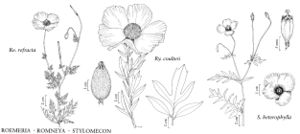Plants to 6 dm, glabrescent to sparsely setose. Stems simple or usually branching. Leaves to 10 cm; petiole to 2 cm; blade with margins entire; ultimate lobes lanceolate to linear, usually tipped with short, delicate bristles. Inflorescences: peduncle to 15 cm. Flowers: petals to 4 cm, bright red with black basal spot sometimes edged white; filaments dark violet to blackish. Capsules to 10 cm, straight to slightly curved, glabrous to sparsely hirsute or setose, valves usually tipped with distinct awns extending beyond stigmas. Seeds gray, reticulate-pitted.
Phenology: Flowering late spring–early summer.
Habitat: Cultivated fields
Elevation: 1200-1500 m
Distribution

Introduced; Utah, s Europe, sw, sc Asia
Discussion
Roemeria refracta has been introduced in Cache and Box Elder counties in Utah, and perhaps elsewhere in temperate and subtropical North America. It is closely related to, and not always clearly distinct from, R. hybrida (Linnaeus) de Candolle, which also ranges from southern Europe to south-central Asia and could be introduced into North America. The most obvious difference between the two species is in petal coloration–bright red with a blackish basal spot sometimes edged with white in R. refracta, and violet with or without a blackish basal spot in R. hybrida–a distinction that apparently is consistent throughout their generally overlapping native ranges. However, some Asian and southeast European plants, and some of the North American introductions, are intermediate in one or both of the other characters that have been used to separate the two species: the nature of any capsule pubescence, and the presence of awns on the tips of the capsule valves. Typical R. refracta has capsules that are either glabrous or appressed-bristly, with valves bearing distinct terminal awns that clearly extend beyond the level of the stigmas, whereas typical R. hybrida has capsules that are either glabrous or spreading-bristly, with valves not awn-tipped. In some specimens of R. refracta, though, capsule pubescence is spreading or even patent rather than appressed, and in some the valve awns are reduced or absent. As well, some plants otherwise attributable to R. hybrida have capsule pubescence that is more appressed than spreading.
Selected References
None.
